The Brake Rotor, Pad, Line, Fluid, and Duct Thread
#121
Evolving Member
iTrader: (35)
I dont have any experience with the Girodisc so I wont comment on its thermal capacity, but you can definetely reduce the front load by adding more rear brake.
The stock Evo comes with a 70.1/29.9 brake bias using the same friction front and rear. Gramma tales say to run a more aggressive friction in the front which is total crap since the OE bias is already stupid proof. So in order to actually get a bit more braking performance its better to actually have 1 step more agressive pads in the rear. Specially since the Evo/STI are AWD which can safely run the most rear bias out of all platforms.
That being said, running a less agressive pad in the front will keep things cooler and last longer.
PFC 97 front and PFC 01 rear works great with the perfect split.
The stock Evo comes with a 70.1/29.9 brake bias using the same friction front and rear. Gramma tales say to run a more aggressive friction in the front which is total crap since the OE bias is already stupid proof. So in order to actually get a bit more braking performance its better to actually have 1 step more agressive pads in the rear. Specially since the Evo/STI are AWD which can safely run the most rear bias out of all platforms.
That being said, running a less agressive pad in the front will keep things cooler and last longer.
PFC 97 front and PFC 01 rear works great with the perfect split.

Another question: should I remove my front OEM rotor dust shields to increase the rotors' exposure to cooling air? Remember, in my case, I'm already using brake cooling ducts.
#122
Former Sponsor
iTrader: (67)
Join Date: Aug 2006
Location: Cary, NC
Posts: 1,000
Likes: 0
Received 0 Likes
on
0 Posts
A few thoughts on the heat.
Even if the pads are said to be good to 2000 degrees - the rest of your brakes are not. Ideally you'll be in the low 1000's or so for optimal performance. Past 1500ish everything starts to wear/fail so much more rapidly.
I am not so sure running less pad up front will decrease temp's/improve wear unless you brake less. From an energy standpoint that is the only way to put less load into the pads.
Even if the pads are said to be good to 2000 degrees - the rest of your brakes are not. Ideally you'll be in the low 1000's or so for optimal performance. Past 1500ish everything starts to wear/fail so much more rapidly.
I am not so sure running less pad up front will decrease temp's/improve wear unless you brake less. From an energy standpoint that is the only way to put less load into the pads.
#123
Former Sponsor
iTrader: (67)
Join Date: Aug 2006
Location: Cary, NC
Posts: 1,000
Likes: 0
Received 0 Likes
on
0 Posts
Awesome; thank you for your input Ferreira! Has anyone had experience with running Raybestos ST-43s in the front, and ST-41s in the rear? From what I've read, the Raybestos pads appear to last longer than PFC.
Another question: should I remove my front OEM rotor dust shields to increase the rotors' exposure to cooling air? Remember, in my case, I'm already using brake cooling ducts.
Another question: should I remove my front OEM rotor dust shields to increase the rotors' exposure to cooling air? Remember, in my case, I'm already using brake cooling ducts.
But remember - they also shield tie rod ends etc from rotor heat so you have to wrap everything that becomes exposed.
#124
Former Sponsor
iTrader: (67)
Join Date: Aug 2006
Location: Cary, NC
Posts: 1,000
Likes: 0
Received 0 Likes
on
0 Posts
I would fully expect set of front race pads to last about 2 weekends at most (roughly 2 track hours per day - 4-30 min session) - or less.
?
#125
Former Sponsor
iTrader: (67)
Join Date: Aug 2006
Location: Cary, NC
Posts: 1,000
Likes: 0
Received 0 Likes
on
0 Posts
Just another thought
I think the wear accelerates rapidly with temperature.
In other words - for the first 10-15 mins of the session the wear is low as heat builds.
Then the rotor/caliper/wheel/pads etc start to get soaked and temps continue up -
We know temps can exceed 1500 ish - perhaps the majority of wear occurs in those last few laps when the whole system is soaked and heat cannot be rejected?
I think the wear accelerates rapidly with temperature.
In other words - for the first 10-15 mins of the session the wear is low as heat builds.
Then the rotor/caliper/wheel/pads etc start to get soaked and temps continue up -
We know temps can exceed 1500 ish - perhaps the majority of wear occurs in those last few laps when the whole system is soaked and heat cannot be rejected?
Last edited by EVOBrakes; Aug 11, 2009 at 10:11 AM.
#126
Former Sponsor
iTrader: (67)
Join Date: Aug 2006
Location: Cary, NC
Posts: 1,000
Likes: 0
Received 0 Likes
on
0 Posts
I've got an Evo X so would like to confirm that X's fronts are same as 8/9.
Anyone got an X that has some good rear brakes to offer? I want to be able to have DD/street and track pads available to use as appropriate, and the OEM Brembo ones for $300 F and $300 R are not good for either street or track (street -- too pricey; track -- not able to handle the heat).
Would also like to know if any of the 8/9 air dam guides will fit on my X? I have the aero package and the dang Mitsu dealer didn't tell me that guides were more-or-less required with that option. Boneheads.
Anyone got an X that has some good rear brakes to offer? I want to be able to have DD/street and track pads available to use as appropriate, and the OEM Brembo ones for $300 F and $300 R are not good for either street or track (street -- too pricey; track -- not able to handle the heat).
Would also like to know if any of the 8/9 air dam guides will fit on my X? I have the aero package and the dang Mitsu dealer didn't tell me that guides were more-or-less required with that option. Boneheads.
Rear race pads are available now
#127
Just another thought
I know the wear accelerates rapidyl with temperature.
In other words - for the first 10-15 mins of the session the wear is low as heat builds.
Then the rotor/caliper/wheel/pads etc start to get soaked and temps continue up -
We know temps can exceed 1500 ish - perhaps the majority of wear occurs in those last few laps when the whole system is soaked and heat cannot be rejected?
I know the wear accelerates rapidyl with temperature.
In other words - for the first 10-15 mins of the session the wear is low as heat builds.
Then the rotor/caliper/wheel/pads etc start to get soaked and temps continue up -
We know temps can exceed 1500 ish - perhaps the majority of wear occurs in those last few laps when the whole system is soaked and heat cannot be rejected?

Pads can turn to flaming dust past their MOT. Thats why its really important to know what the MOT is and what temps you are really seeing when tracking.
#128
Former Sponsor
iTrader: (67)
Join Date: Aug 2006
Location: Cary, NC
Posts: 1,000
Likes: 0
Received 0 Likes
on
0 Posts
So how does running a lesser compound increase life unless you brake less. Power/energy are unaffected by compound of course - you brake at a certain rate - you absorb a certain amount of power/energy. Unless you divert that elsewhere (rear?) or make less of it I would think a lesser pad would wear faster.
I certainly saw that when I ran HT-10's after I had gotten faster/added tire. They simply melted.
#129
I also agree. I would NOT run a lesser pad up front. Its still important to run r-coefs that are in line with each other. You can cause unstable braking doing that.
It will take longer to stop with lesser r-coef pads up front, thus build more heat (and wear faster).
It will take longer to stop with lesser r-coef pads up front, thus build more heat (and wear faster).
#130
Former Sponsor
iTrader: (67)
Join Date: Aug 2006
Location: Cary, NC
Posts: 1,000
Likes: 0
Received 0 Likes
on
0 Posts
From an energy standpoint - 120-45 MPH stop would create the same amount of heat (energy) regardless of the rate of decel. That's sophmore physics
From a power standpoint - 120-45 in say 2 seconds versus 4 seconds. Power to decel from 120-45 is same as accel from 45-120 taking out wind resistance for calculations sake. Obviously it takes MUCH more power to accel (or decel) that amount in 2 seconds versus 4 seconds. More power = more heat?
If we choose the power method....
So if that makes sense - than shorter harder stops would create more heat - I think yes - BUT - more time off the brakes increases airflow around the pad when it moves away from the rotor etc.
Which one wins.
In my opinion that's rhetorical - more power = more heat.
So now I know why I wear pads fast.
a) I run R compounds - tons of grip
b) I increase power - so terminal speeds are higher
c) I brake late and hard - but not late enough yet as my instructors say
c) I'm an average driver at best so my turn in speed is LOWER than a 'better' driver
That says that my braking events are
-High Power (thus high heat)
-Longish (I slow down more than I need to since I'm a wuss on track)
#131
 Ok, more power = more heat. Correct energy would be the same, but time on the brakes to achieve that goal is what I was after. It will take longer on lower r-coef pads to do that 120-45 stop, longer on the brakes - more heat there is to build up. You have it with the time off brakes - you will then have a longer cooling period.
Ok, more power = more heat. Correct energy would be the same, but time on the brakes to achieve that goal is what I was after. It will take longer on lower r-coef pads to do that 120-45 stop, longer on the brakes - more heat there is to build up. You have it with the time off brakes - you will then have a longer cooling period.
#132
Evolved Member
iTrader: (62)
Join Date: Feb 2004
Location: Redmond - Lake Tapps ,WA
Posts: 3,336
Likes: 0
Received 6 Likes
on
6 Posts
Video of how the car is driven, on 265 BFG R1's....
http://www.vimeo.com/5365021
Evobrakes - you sound like a salesman, not everything you said is factual, or backed up with any sort of data...
Like this for example. I have temperature plots of the pad temp - but I'll keep those to myself for now.
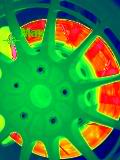
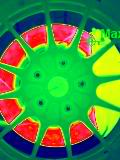
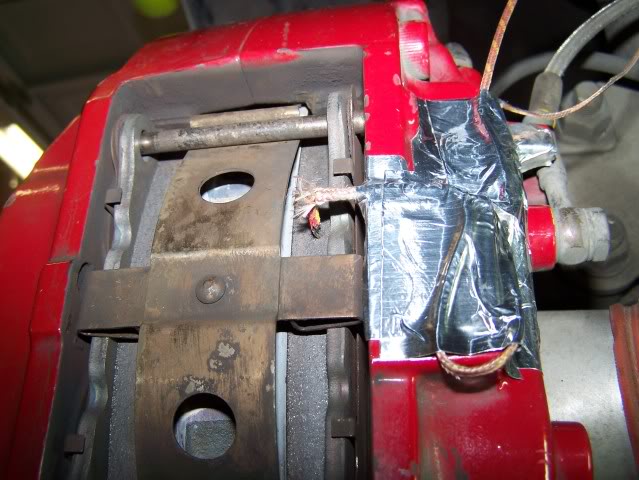
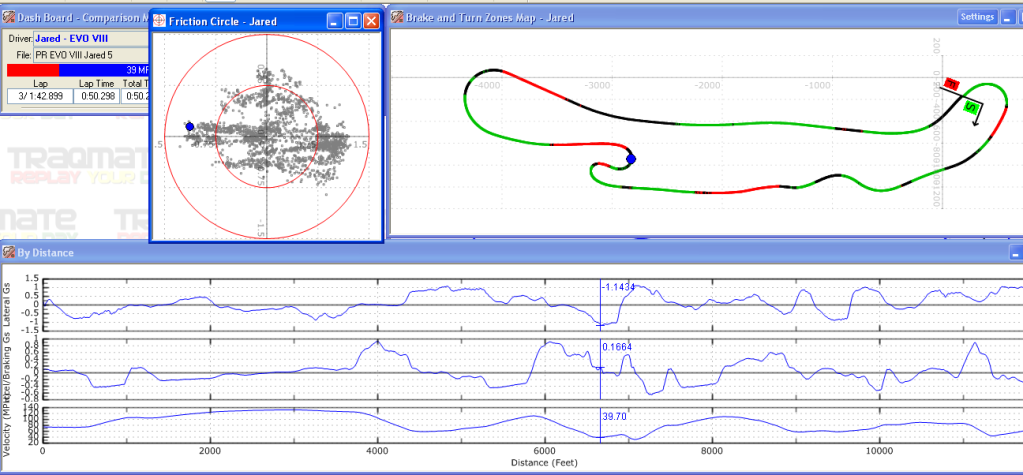
#133
Former Sponsor
iTrader: (67)
Join Date: Aug 2006
Location: Cary, NC
Posts: 1,000
Likes: 0
Received 0 Likes
on
0 Posts
There is wear, but the % vs a new pad is small. The Raybestos ST43's wear very nicely when ran at the proper temps.
Video of how the car is driven, on 265 BFG R1's....
http://www.vimeo.com/5365021
Evobrakes - you sound like a salesman, not everything you said is factual, or backed up with any sort of data...
Like this for example. I have temperature plots of the pad temp - but I'll keep those to myself for now.


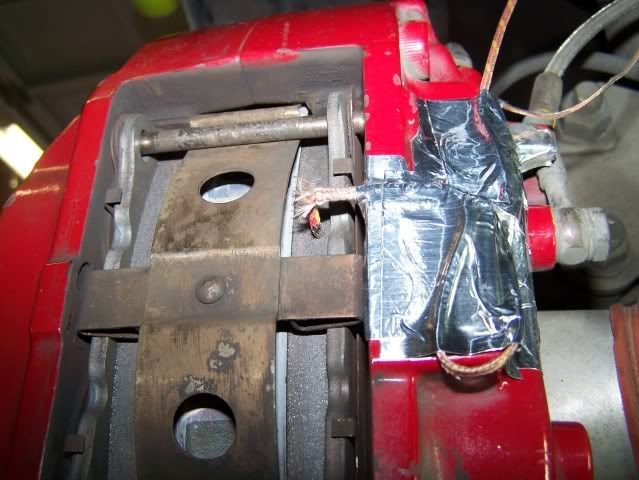
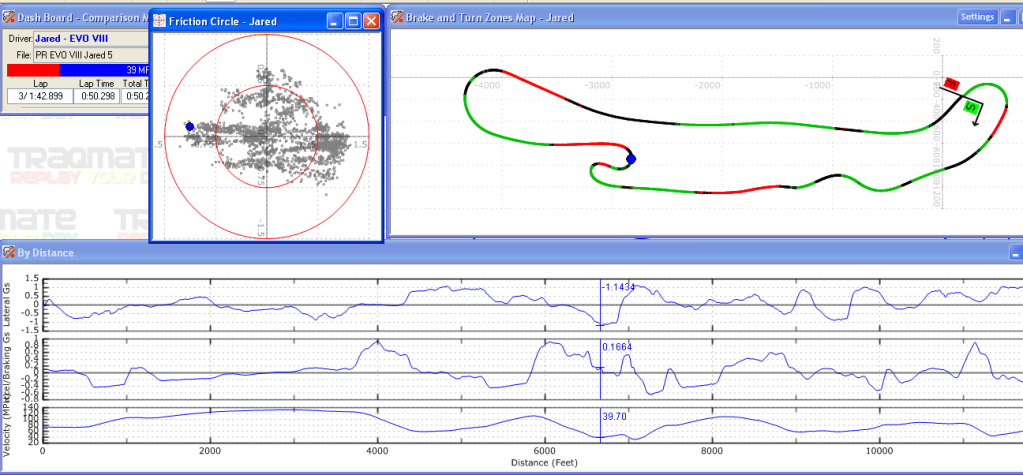
Video of how the car is driven, on 265 BFG R1's....
http://www.vimeo.com/5365021
Evobrakes - you sound like a salesman, not everything you said is factual, or backed up with any sort of data...
Like this for example. I have temperature plots of the pad temp - but I'll keep those to myself for now.




I am off to ship - but I know what I'll be looking at later.
-Ken
#134
Evolving Member
iTrader: (35)
So how does running a lesser compound increase life unless you brake less. Power/energy are unaffected by compound of course - you brake at a certain rate - you absorb a certain amount of power/energy. Unless you divert that elsewhere (rear?) or make less of it I would think a lesser pad would wear faster.
I would agree that running a "lesser" front pad that will overheat/turn into dust faster than the rear would be a bad idea. What I'm suggesting, and hoping may be true, is that running a MORE AGGRESSIVE pad in the rear to shift some of the "work" towards the rear axle would help the front brakes not work as hard, as long as the front brakes weren't being pushed beyond their MOT as a result.
For this to work, I think, the front pads would have to have a high MOT (1600-2000), but also comprise a HARDER compound that would naturally have a lower coefficient of friction than the rears.
Maybe such an animal doesn't exist - a less grippy compound that still handles extreme heat. I've been told that brake pads capable of really strong decel by nature wear quickly and are friendlier to rotors because they utilize relatively-soft compounds to achieve their high coefficients of friction. But I have no idea if this is true; I'm neither an engineer nor an expert on brake pads.
#135
Sadly, most racing pad manufactures do not release their drag coefficients only qualifiers like med-high torque.
Do you have an IR gun? Next track day, IR gun all rotors and pads. See how big of a split there is from front to rear. With my Evo, I was seeing something like 900+ up front and 600s in the rear (right after the cool down lap - on HT10/GS5 pads, street tires).
But in the end, the fronts do a ton of work. Rears do not have the same friction area. And pads are consumables.
Do you have an IR gun? Next track day, IR gun all rotors and pads. See how big of a split there is from front to rear. With my Evo, I was seeing something like 900+ up front and 600s in the rear (right after the cool down lap - on HT10/GS5 pads, street tires).
But in the end, the fronts do a ton of work. Rears do not have the same friction area. And pads are consumables.

